Analysis of Communication in Health and Social Care Module
VerifiedAdded on 2023/06/04
|16
|3213
|88
Essay
AI Summary
This essay provides an evidence-based definition of communication and evaluates key attributes of effective communication strategies within health and social care settings. It explores various theoretical concepts, emphasizing the significance of communication in improving healthcare service quality. The essay identifies and discusses communication barriers that impact healthcare delivery, such as cultural and language differences, and proposes mitigative strategies to overcome these obstacles. It also examines the role of interpersonal interactions, non-verbal communication, and active listening in fostering trust and improving patient outcomes. The reflective account highlights the need for developing interpersonal communication skills, identifying barriers, and implementing strategies to enhance patient-centered care. Overall, the essay underscores the importance of effective communication for delivering comprehensive health and social care practices.
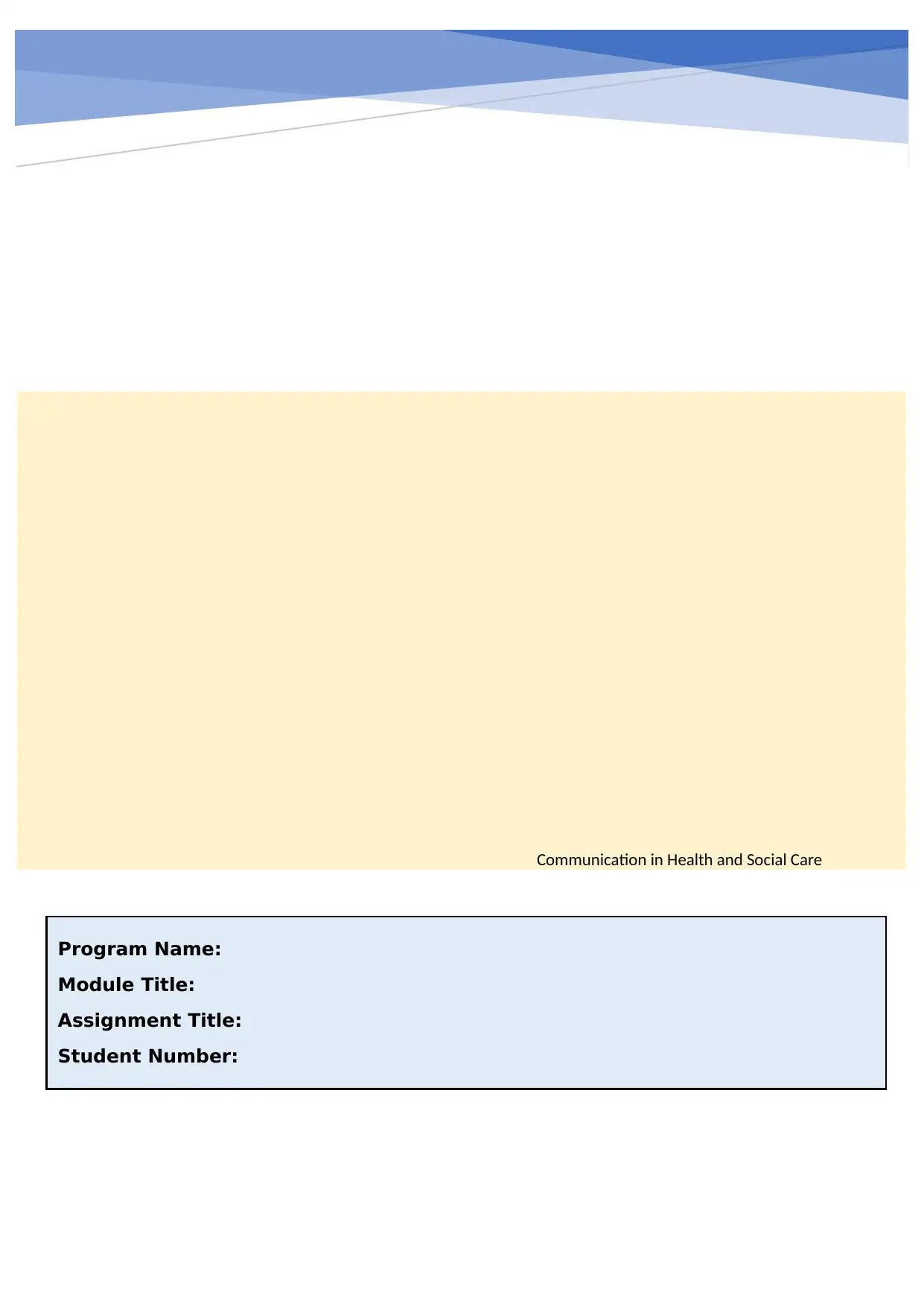
Communication in Health and Social Care
Program Name:
Module Title:
Assignment Title:
Student Number:
Program Name:
Module Title:
Assignment Title:
Student Number:
Paraphrase This Document
Need a fresh take? Get an instant paraphrase of this document with our AI Paraphraser
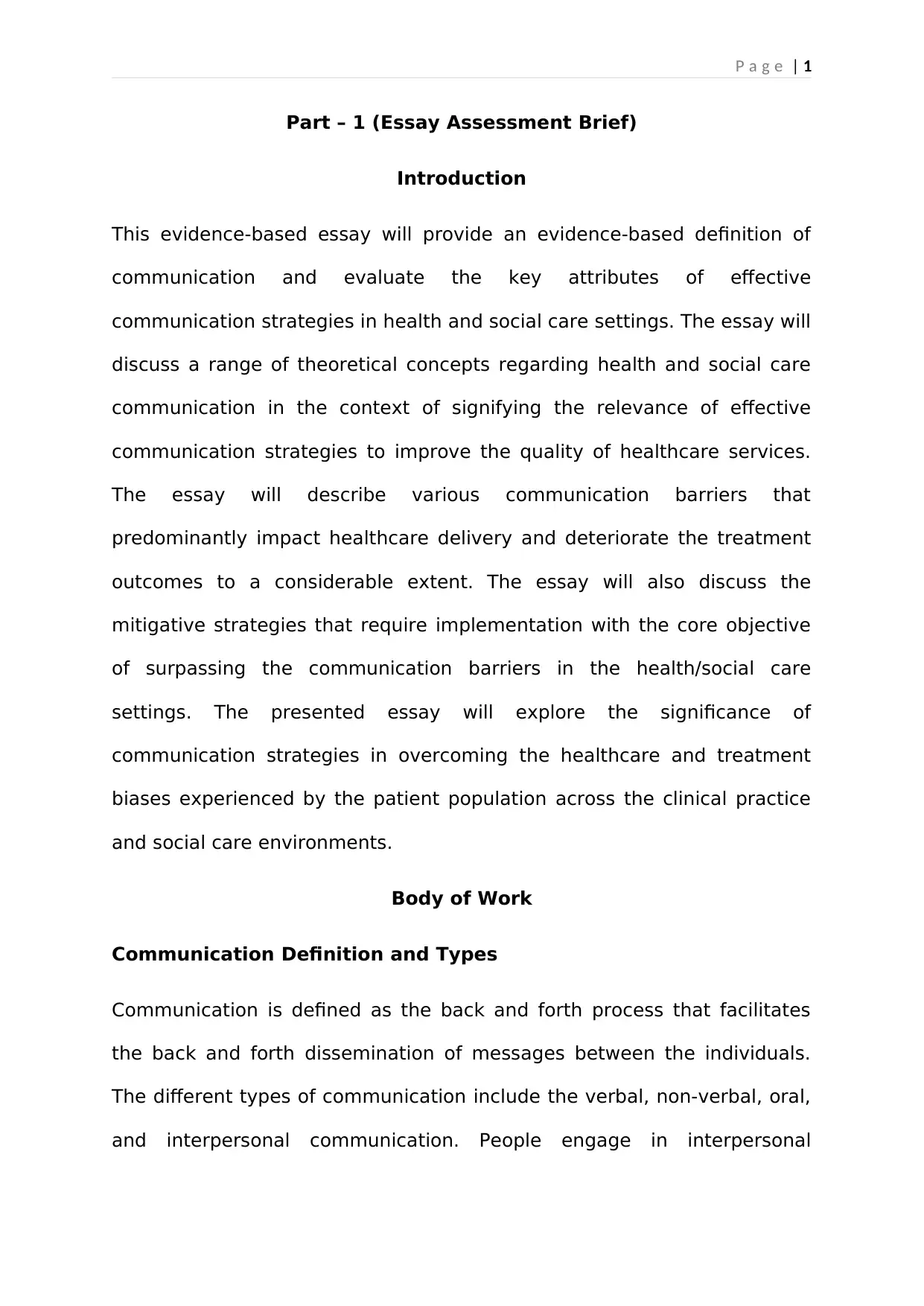
P a g e | 1
Part – 1 (Essay Assessment Brief)
Introduction
This evidence-based essay will provide an evidence-based definition of
communication and evaluate the key attributes of effective
communication strategies in health and social care settings. The essay will
discuss a range of theoretical concepts regarding health and social care
communication in the context of signifying the relevance of effective
communication strategies to improve the quality of healthcare services.
The essay will describe various communication barriers that
predominantly impact healthcare delivery and deteriorate the treatment
outcomes to a considerable extent. The essay will also discuss the
mitigative strategies that require implementation with the core objective
of surpassing the communication barriers in the health/social care
settings. The presented essay will explore the significance of
communication strategies in overcoming the healthcare and treatment
biases experienced by the patient population across the clinical practice
and social care environments.
Body of Work
Communication Definition and Types
Communication is defined as the back and forth process that facilitates
the back and forth dissemination of messages between the individuals.
The different types of communication include the verbal, non-verbal, oral,
and interpersonal communication. People engage in interpersonal
Part – 1 (Essay Assessment Brief)
Introduction
This evidence-based essay will provide an evidence-based definition of
communication and evaluate the key attributes of effective
communication strategies in health and social care settings. The essay will
discuss a range of theoretical concepts regarding health and social care
communication in the context of signifying the relevance of effective
communication strategies to improve the quality of healthcare services.
The essay will describe various communication barriers that
predominantly impact healthcare delivery and deteriorate the treatment
outcomes to a considerable extent. The essay will also discuss the
mitigative strategies that require implementation with the core objective
of surpassing the communication barriers in the health/social care
settings. The presented essay will explore the significance of
communication strategies in overcoming the healthcare and treatment
biases experienced by the patient population across the clinical practice
and social care environments.
Body of Work
Communication Definition and Types
Communication is defined as the back and forth process that facilitates
the back and forth dissemination of messages between the individuals.
The different types of communication include the verbal, non-verbal, oral,
and interpersonal communication. People engage in interpersonal
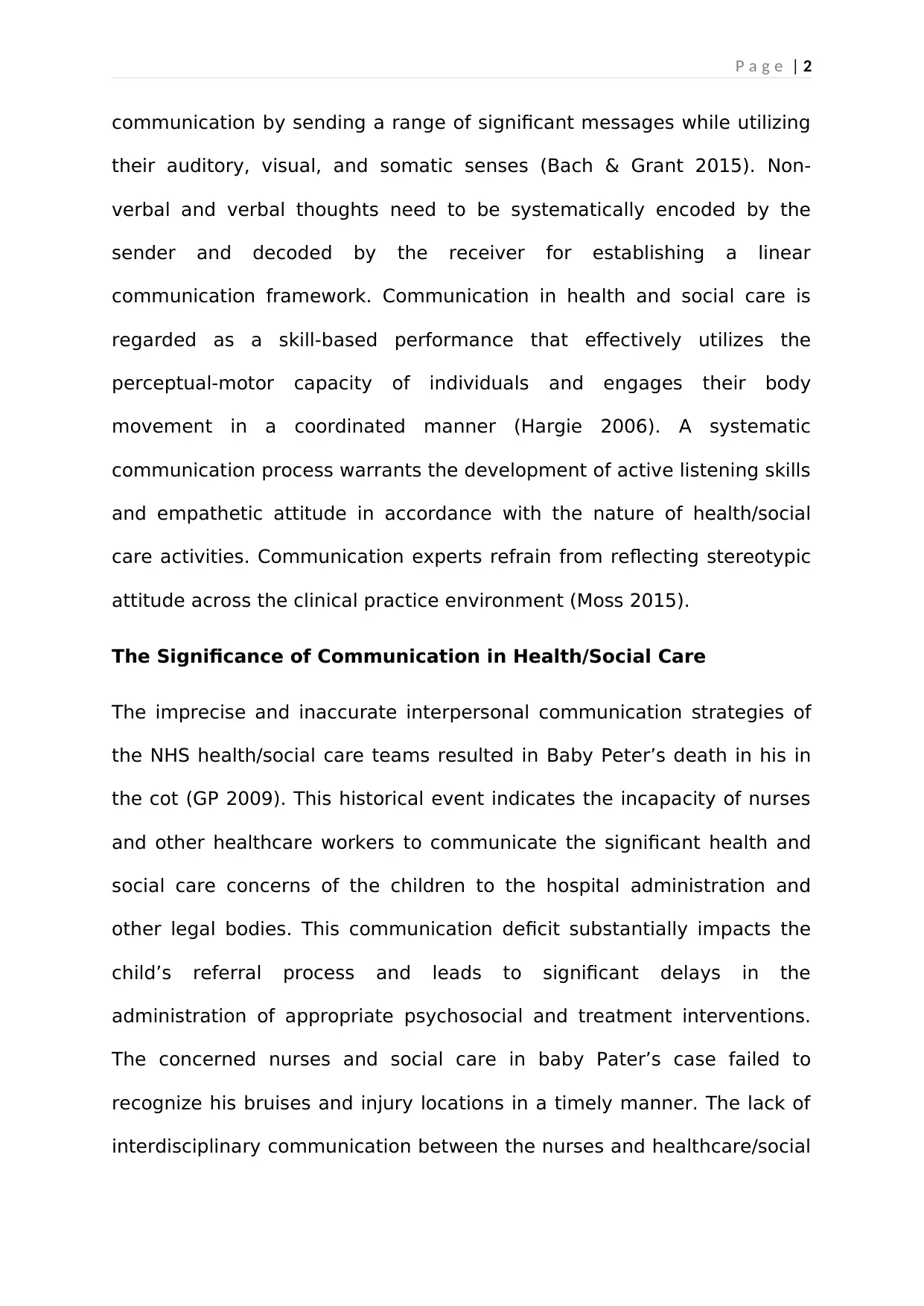
P a g e | 2
communication by sending a range of significant messages while utilizing
their auditory, visual, and somatic senses (Bach & Grant 2015). Non-
verbal and verbal thoughts need to be systematically encoded by the
sender and decoded by the receiver for establishing a linear
communication framework. Communication in health and social care is
regarded as a skill-based performance that effectively utilizes the
perceptual-motor capacity of individuals and engages their body
movement in a coordinated manner (Hargie 2006). A systematic
communication process warrants the development of active listening skills
and empathetic attitude in accordance with the nature of health/social
care activities. Communication experts refrain from reflecting stereotypic
attitude across the clinical practice environment (Moss 2015).
The Significance of Communication in Health/Social Care
The imprecise and inaccurate interpersonal communication strategies of
the NHS health/social care teams resulted in Baby Peter’s death in his in
the cot (GP 2009). This historical event indicates the incapacity of nurses
and other healthcare workers to communicate the significant health and
social care concerns of the children to the hospital administration and
other legal bodies. This communication deficit substantially impacts the
child’s referral process and leads to significant delays in the
administration of appropriate psychosocial and treatment interventions.
The concerned nurses and social care in baby Pater’s case failed to
recognize his bruises and injury locations in a timely manner. The lack of
interdisciplinary communication between the nurses and healthcare/social
communication by sending a range of significant messages while utilizing
their auditory, visual, and somatic senses (Bach & Grant 2015). Non-
verbal and verbal thoughts need to be systematically encoded by the
sender and decoded by the receiver for establishing a linear
communication framework. Communication in health and social care is
regarded as a skill-based performance that effectively utilizes the
perceptual-motor capacity of individuals and engages their body
movement in a coordinated manner (Hargie 2006). A systematic
communication process warrants the development of active listening skills
and empathetic attitude in accordance with the nature of health/social
care activities. Communication experts refrain from reflecting stereotypic
attitude across the clinical practice environment (Moss 2015).
The Significance of Communication in Health/Social Care
The imprecise and inaccurate interpersonal communication strategies of
the NHS health/social care teams resulted in Baby Peter’s death in his in
the cot (GP 2009). This historical event indicates the incapacity of nurses
and other healthcare workers to communicate the significant health and
social care concerns of the children to the hospital administration and
other legal bodies. This communication deficit substantially impacts the
child’s referral process and leads to significant delays in the
administration of appropriate psychosocial and treatment interventions.
The concerned nurses and social care in baby Pater’s case failed to
recognize his bruises and injury locations in a timely manner. The lack of
interdisciplinary communication between the nurses and healthcare/social
⊘ This is a preview!⊘
Do you want full access?
Subscribe today to unlock all pages.

Trusted by 1+ million students worldwide
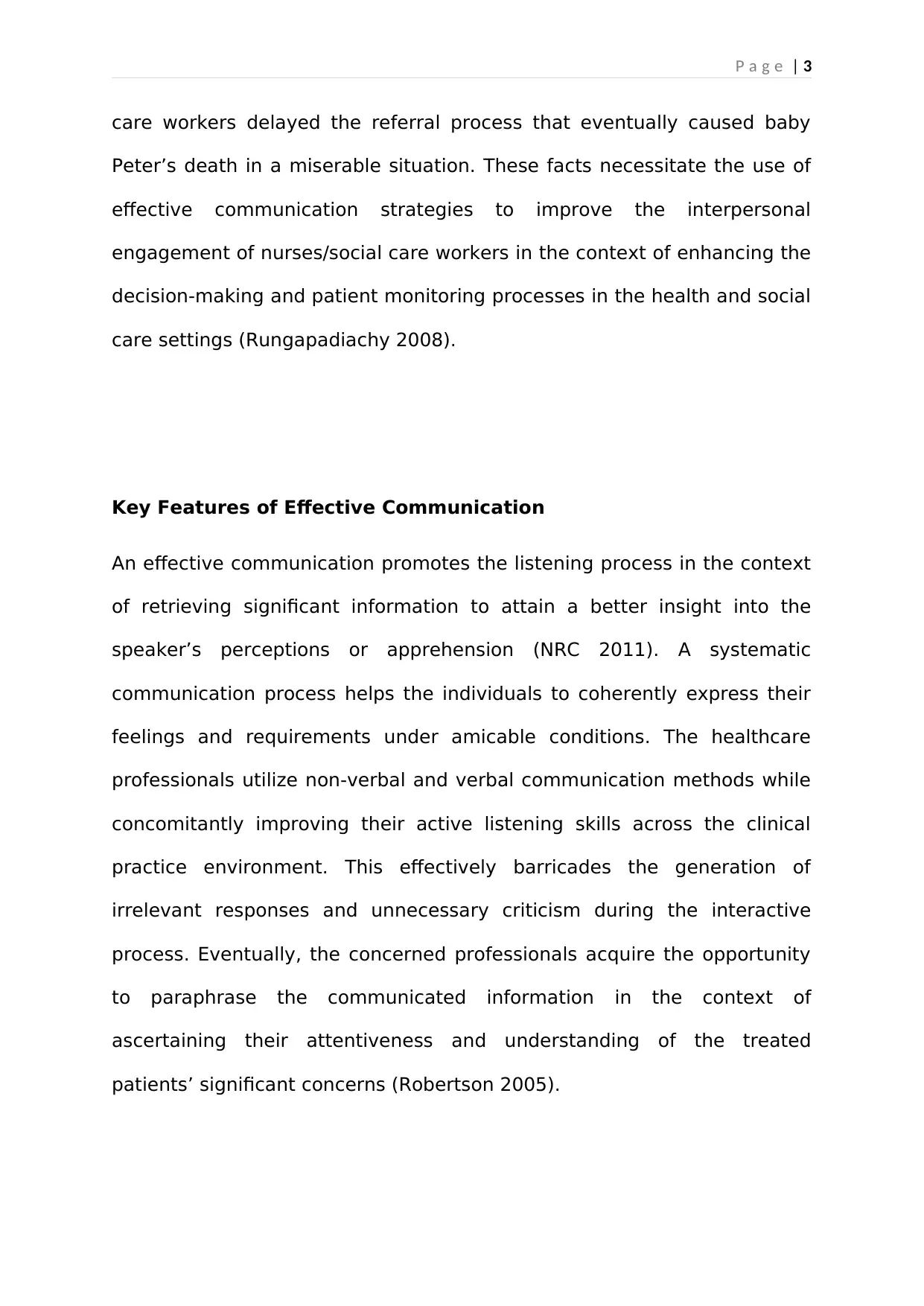
P a g e | 3
care workers delayed the referral process that eventually caused baby
Peter’s death in a miserable situation. These facts necessitate the use of
effective communication strategies to improve the interpersonal
engagement of nurses/social care workers in the context of enhancing the
decision-making and patient monitoring processes in the health and social
care settings (Rungapadiachy 2008).
Key Features of Effective Communication
An effective communication promotes the listening process in the context
of retrieving significant information to attain a better insight into the
speaker’s perceptions or apprehension (NRC 2011). A systematic
communication process helps the individuals to coherently express their
feelings and requirements under amicable conditions. The healthcare
professionals utilize non-verbal and verbal communication methods while
concomitantly improving their active listening skills across the clinical
practice environment. This effectively barricades the generation of
irrelevant responses and unnecessary criticism during the interactive
process. Eventually, the concerned professionals acquire the opportunity
to paraphrase the communicated information in the context of
ascertaining their attentiveness and understanding of the treated
patients’ significant concerns (Robertson 2005).
care workers delayed the referral process that eventually caused baby
Peter’s death in a miserable situation. These facts necessitate the use of
effective communication strategies to improve the interpersonal
engagement of nurses/social care workers in the context of enhancing the
decision-making and patient monitoring processes in the health and social
care settings (Rungapadiachy 2008).
Key Features of Effective Communication
An effective communication promotes the listening process in the context
of retrieving significant information to attain a better insight into the
speaker’s perceptions or apprehension (NRC 2011). A systematic
communication process helps the individuals to coherently express their
feelings and requirements under amicable conditions. The healthcare
professionals utilize non-verbal and verbal communication methods while
concomitantly improving their active listening skills across the clinical
practice environment. This effectively barricades the generation of
irrelevant responses and unnecessary criticism during the interactive
process. Eventually, the concerned professionals acquire the opportunity
to paraphrase the communicated information in the context of
ascertaining their attentiveness and understanding of the treated
patients’ significant concerns (Robertson 2005).
Paraphrase This Document
Need a fresh take? Get an instant paraphrase of this document with our AI Paraphraser
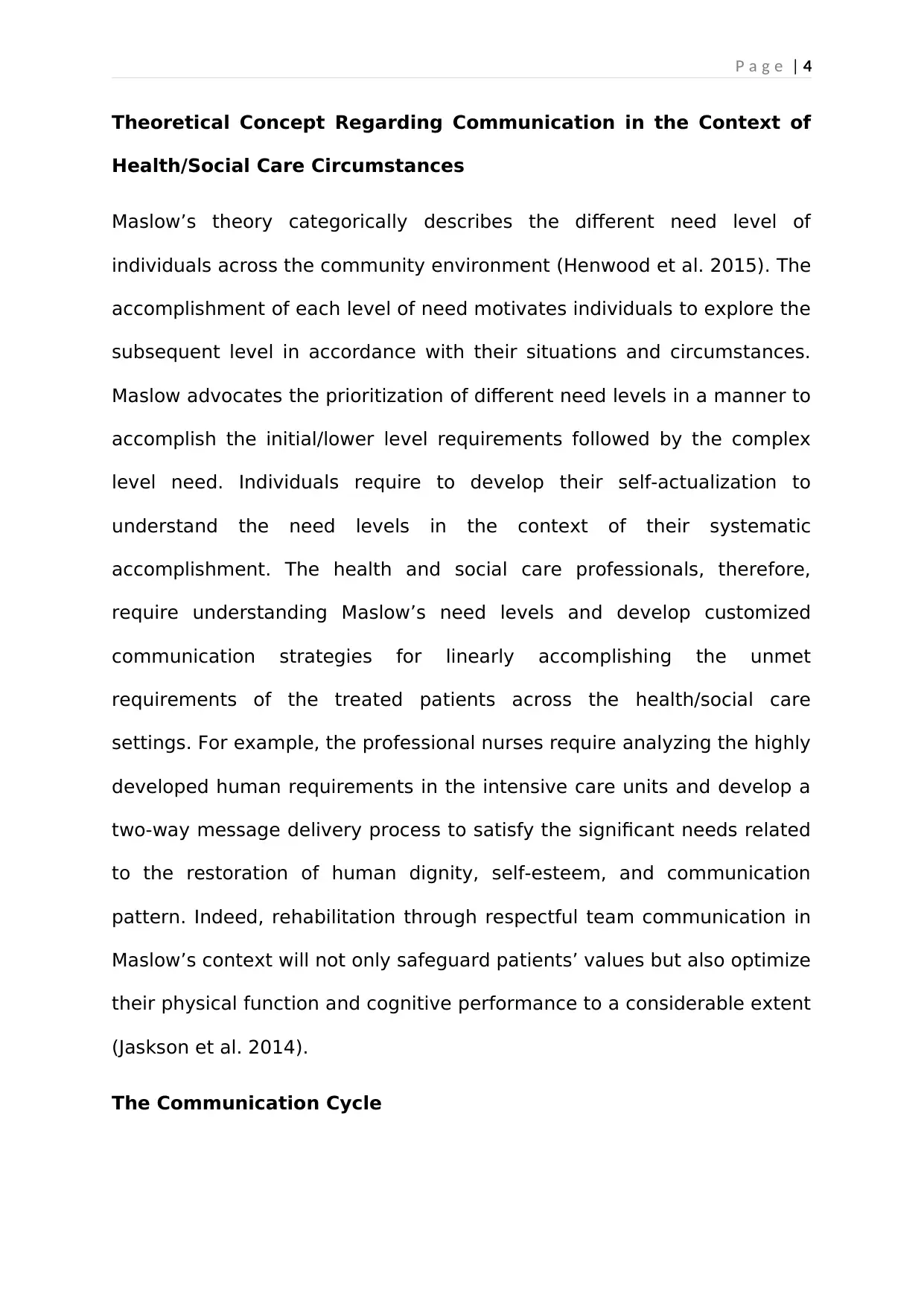
P a g e | 4
Theoretical Concept Regarding Communication in the Context of
Health/Social Care Circumstances
Maslow’s theory categorically describes the different need level of
individuals across the community environment (Henwood et al. 2015). The
accomplishment of each level of need motivates individuals to explore the
subsequent level in accordance with their situations and circumstances.
Maslow advocates the prioritization of different need levels in a manner to
accomplish the initial/lower level requirements followed by the complex
level need. Individuals require to develop their self-actualization to
understand the need levels in the context of their systematic
accomplishment. The health and social care professionals, therefore,
require understanding Maslow’s need levels and develop customized
communication strategies for linearly accomplishing the unmet
requirements of the treated patients across the health/social care
settings. For example, the professional nurses require analyzing the highly
developed human requirements in the intensive care units and develop a
two-way message delivery process to satisfy the significant needs related
to the restoration of human dignity, self-esteem, and communication
pattern. Indeed, rehabilitation through respectful team communication in
Maslow’s context will not only safeguard patients’ values but also optimize
their physical function and cognitive performance to a considerable extent
(Jaskson et al. 2014).
The Communication Cycle
Theoretical Concept Regarding Communication in the Context of
Health/Social Care Circumstances
Maslow’s theory categorically describes the different need level of
individuals across the community environment (Henwood et al. 2015). The
accomplishment of each level of need motivates individuals to explore the
subsequent level in accordance with their situations and circumstances.
Maslow advocates the prioritization of different need levels in a manner to
accomplish the initial/lower level requirements followed by the complex
level need. Individuals require to develop their self-actualization to
understand the need levels in the context of their systematic
accomplishment. The health and social care professionals, therefore,
require understanding Maslow’s need levels and develop customized
communication strategies for linearly accomplishing the unmet
requirements of the treated patients across the health/social care
settings. For example, the professional nurses require analyzing the highly
developed human requirements in the intensive care units and develop a
two-way message delivery process to satisfy the significant needs related
to the restoration of human dignity, self-esteem, and communication
pattern. Indeed, rehabilitation through respectful team communication in
Maslow’s context will not only safeguard patients’ values but also optimize
their physical function and cognitive performance to a considerable extent
(Jaskson et al. 2014).
The Communication Cycle
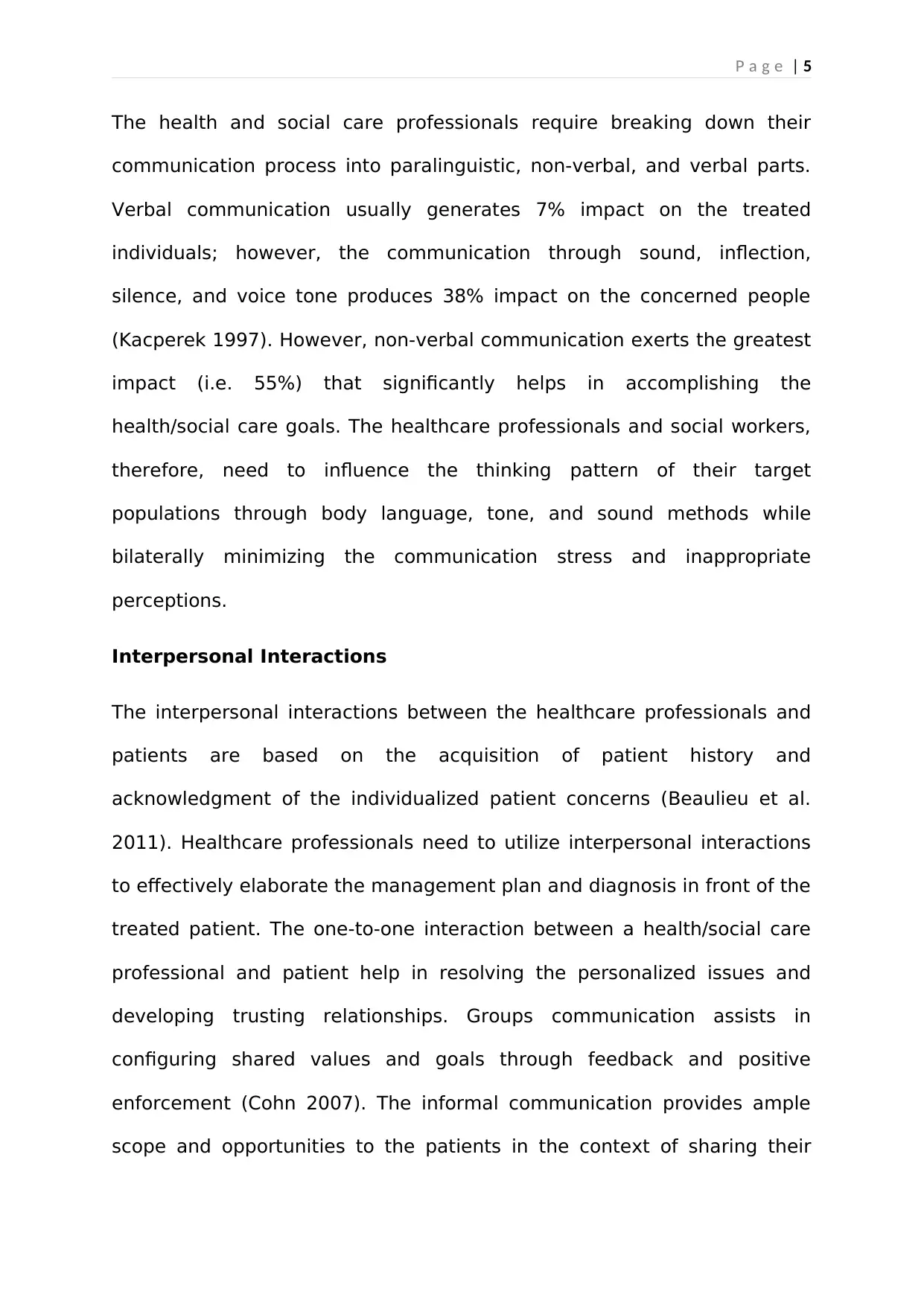
P a g e | 5
The health and social care professionals require breaking down their
communication process into paralinguistic, non-verbal, and verbal parts.
Verbal communication usually generates 7% impact on the treated
individuals; however, the communication through sound, inflection,
silence, and voice tone produces 38% impact on the concerned people
(Kacperek 1997). However, non-verbal communication exerts the greatest
impact (i.e. 55%) that significantly helps in accomplishing the
health/social care goals. The healthcare professionals and social workers,
therefore, need to influence the thinking pattern of their target
populations through body language, tone, and sound methods while
bilaterally minimizing the communication stress and inappropriate
perceptions.
Interpersonal Interactions
The interpersonal interactions between the healthcare professionals and
patients are based on the acquisition of patient history and
acknowledgment of the individualized patient concerns (Beaulieu et al.
2011). Healthcare professionals need to utilize interpersonal interactions
to effectively elaborate the management plan and diagnosis in front of the
treated patient. The one-to-one interaction between a health/social care
professional and patient help in resolving the personalized issues and
developing trusting relationships. Groups communication assists in
configuring shared values and goals through feedback and positive
enforcement (Cohn 2007). The informal communication provides ample
scope and opportunities to the patients in the context of sharing their
The health and social care professionals require breaking down their
communication process into paralinguistic, non-verbal, and verbal parts.
Verbal communication usually generates 7% impact on the treated
individuals; however, the communication through sound, inflection,
silence, and voice tone produces 38% impact on the concerned people
(Kacperek 1997). However, non-verbal communication exerts the greatest
impact (i.e. 55%) that significantly helps in accomplishing the
health/social care goals. The healthcare professionals and social workers,
therefore, need to influence the thinking pattern of their target
populations through body language, tone, and sound methods while
bilaterally minimizing the communication stress and inappropriate
perceptions.
Interpersonal Interactions
The interpersonal interactions between the healthcare professionals and
patients are based on the acquisition of patient history and
acknowledgment of the individualized patient concerns (Beaulieu et al.
2011). Healthcare professionals need to utilize interpersonal interactions
to effectively elaborate the management plan and diagnosis in front of the
treated patient. The one-to-one interaction between a health/social care
professional and patient help in resolving the personalized issues and
developing trusting relationships. Groups communication assists in
configuring shared values and goals through feedback and positive
enforcement (Cohn 2007). The informal communication provides ample
scope and opportunities to the patients in the context of sharing their
⊘ This is a preview!⊘
Do you want full access?
Subscribe today to unlock all pages.

Trusted by 1+ million students worldwide
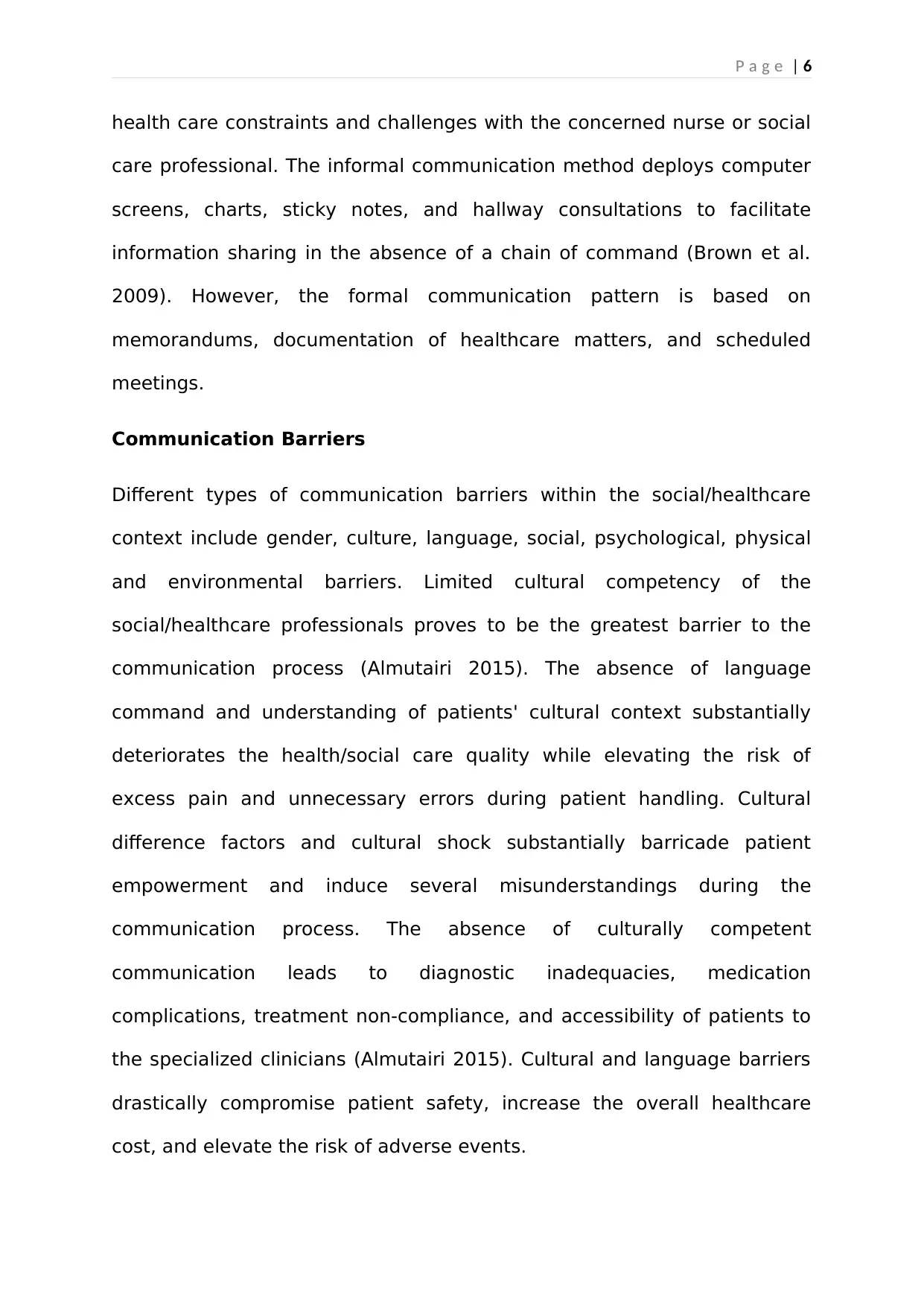
P a g e | 6
health care constraints and challenges with the concerned nurse or social
care professional. The informal communication method deploys computer
screens, charts, sticky notes, and hallway consultations to facilitate
information sharing in the absence of a chain of command (Brown et al.
2009). However, the formal communication pattern is based on
memorandums, documentation of healthcare matters, and scheduled
meetings.
Communication Barriers
Different types of communication barriers within the social/healthcare
context include gender, culture, language, social, psychological, physical
and environmental barriers. Limited cultural competency of the
social/healthcare professionals proves to be the greatest barrier to the
communication process (Almutairi 2015). The absence of language
command and understanding of patients' cultural context substantially
deteriorates the health/social care quality while elevating the risk of
excess pain and unnecessary errors during patient handling. Cultural
difference factors and cultural shock substantially barricade patient
empowerment and induce several misunderstandings during the
communication process. The absence of culturally competent
communication leads to diagnostic inadequacies, medication
complications, treatment non-compliance, and accessibility of patients to
the specialized clinicians (Almutairi 2015). Cultural and language barriers
drastically compromise patient safety, increase the overall healthcare
cost, and elevate the risk of adverse events.
health care constraints and challenges with the concerned nurse or social
care professional. The informal communication method deploys computer
screens, charts, sticky notes, and hallway consultations to facilitate
information sharing in the absence of a chain of command (Brown et al.
2009). However, the formal communication pattern is based on
memorandums, documentation of healthcare matters, and scheduled
meetings.
Communication Barriers
Different types of communication barriers within the social/healthcare
context include gender, culture, language, social, psychological, physical
and environmental barriers. Limited cultural competency of the
social/healthcare professionals proves to be the greatest barrier to the
communication process (Almutairi 2015). The absence of language
command and understanding of patients' cultural context substantially
deteriorates the health/social care quality while elevating the risk of
excess pain and unnecessary errors during patient handling. Cultural
difference factors and cultural shock substantially barricade patient
empowerment and induce several misunderstandings during the
communication process. The absence of culturally competent
communication leads to diagnostic inadequacies, medication
complications, treatment non-compliance, and accessibility of patients to
the specialized clinicians (Almutairi 2015). Cultural and language barriers
drastically compromise patient safety, increase the overall healthcare
cost, and elevate the risk of adverse events.
Paraphrase This Document
Need a fresh take? Get an instant paraphrase of this document with our AI Paraphraser
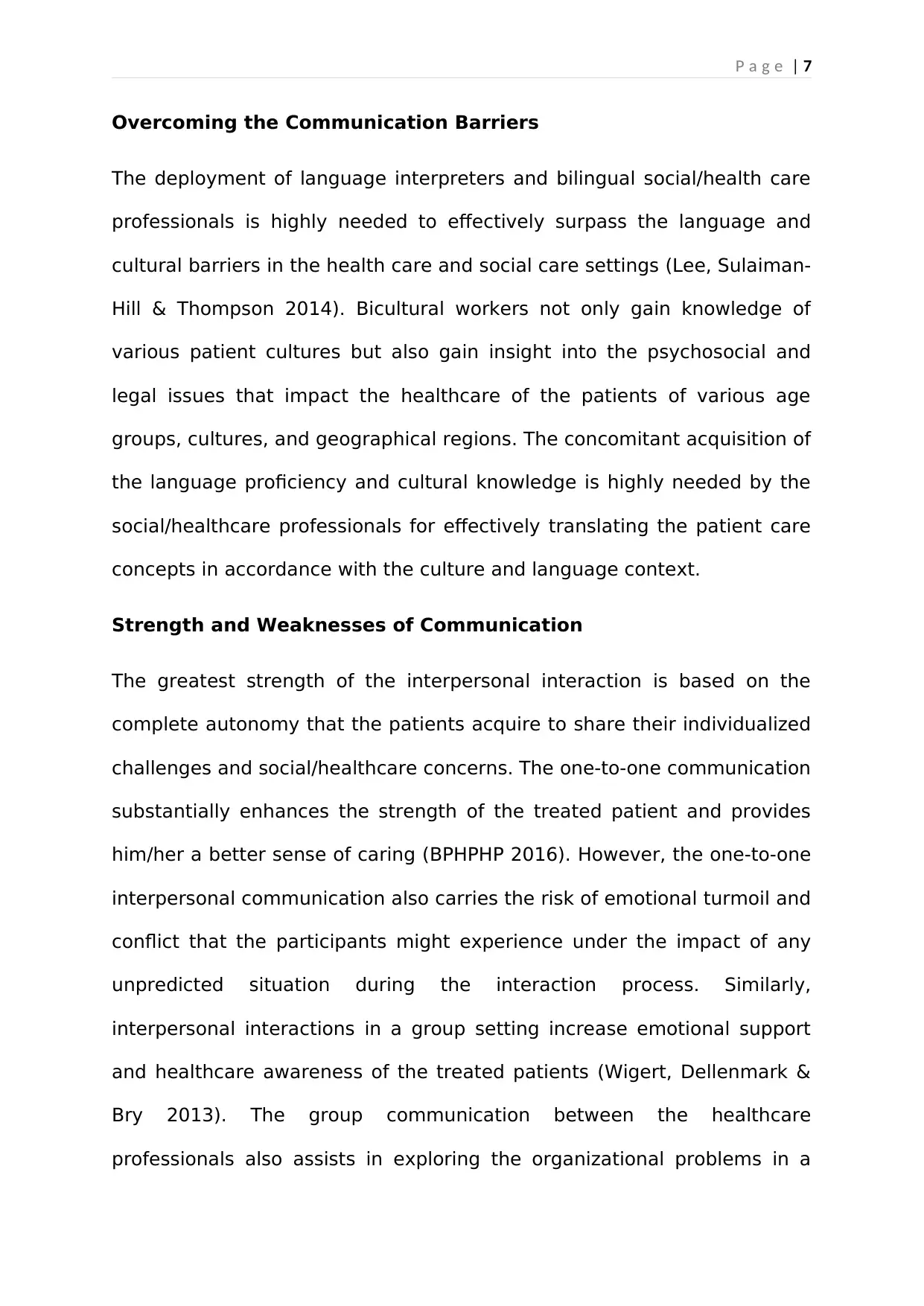
P a g e | 7
Overcoming the Communication Barriers
The deployment of language interpreters and bilingual social/health care
professionals is highly needed to effectively surpass the language and
cultural barriers in the health care and social care settings (Lee, Sulaiman-
Hill & Thompson 2014). Bicultural workers not only gain knowledge of
various patient cultures but also gain insight into the psychosocial and
legal issues that impact the healthcare of the patients of various age
groups, cultures, and geographical regions. The concomitant acquisition of
the language proficiency and cultural knowledge is highly needed by the
social/healthcare professionals for effectively translating the patient care
concepts in accordance with the culture and language context.
Strength and Weaknesses of Communication
The greatest strength of the interpersonal interaction is based on the
complete autonomy that the patients acquire to share their individualized
challenges and social/healthcare concerns. The one-to-one communication
substantially enhances the strength of the treated patient and provides
him/her a better sense of caring (BPHPHP 2016). However, the one-to-one
interpersonal communication also carries the risk of emotional turmoil and
conflict that the participants might experience under the impact of any
unpredicted situation during the interaction process. Similarly,
interpersonal interactions in a group setting increase emotional support
and healthcare awareness of the treated patients (Wigert, Dellenmark &
Bry 2013). The group communication between the healthcare
professionals also assists in exploring the organizational problems in a
Overcoming the Communication Barriers
The deployment of language interpreters and bilingual social/health care
professionals is highly needed to effectively surpass the language and
cultural barriers in the health care and social care settings (Lee, Sulaiman-
Hill & Thompson 2014). Bicultural workers not only gain knowledge of
various patient cultures but also gain insight into the psychosocial and
legal issues that impact the healthcare of the patients of various age
groups, cultures, and geographical regions. The concomitant acquisition of
the language proficiency and cultural knowledge is highly needed by the
social/healthcare professionals for effectively translating the patient care
concepts in accordance with the culture and language context.
Strength and Weaknesses of Communication
The greatest strength of the interpersonal interaction is based on the
complete autonomy that the patients acquire to share their individualized
challenges and social/healthcare concerns. The one-to-one communication
substantially enhances the strength of the treated patient and provides
him/her a better sense of caring (BPHPHP 2016). However, the one-to-one
interpersonal communication also carries the risk of emotional turmoil and
conflict that the participants might experience under the impact of any
unpredicted situation during the interaction process. Similarly,
interpersonal interactions in a group setting increase emotional support
and healthcare awareness of the treated patients (Wigert, Dellenmark &
Bry 2013). The group communication between the healthcare
professionals also assists in exploring the organizational problems in a
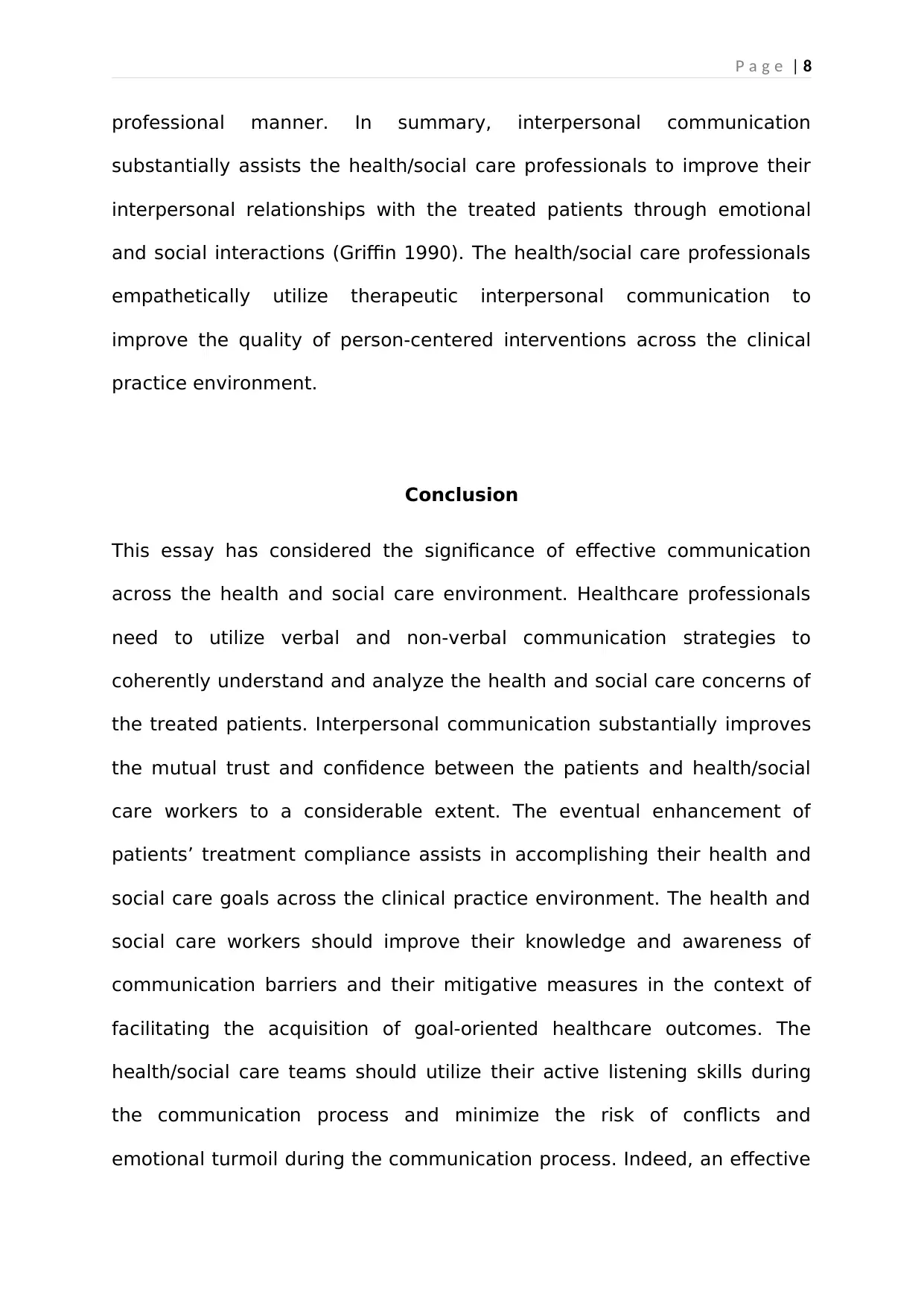
P a g e | 8
professional manner. In summary, interpersonal communication
substantially assists the health/social care professionals to improve their
interpersonal relationships with the treated patients through emotional
and social interactions (Griffin 1990). The health/social care professionals
empathetically utilize therapeutic interpersonal communication to
improve the quality of person-centered interventions across the clinical
practice environment.
Conclusion
This essay has considered the significance of effective communication
across the health and social care environment. Healthcare professionals
need to utilize verbal and non-verbal communication strategies to
coherently understand and analyze the health and social care concerns of
the treated patients. Interpersonal communication substantially improves
the mutual trust and confidence between the patients and health/social
care workers to a considerable extent. The eventual enhancement of
patients’ treatment compliance assists in accomplishing their health and
social care goals across the clinical practice environment. The health and
social care workers should improve their knowledge and awareness of
communication barriers and their mitigative measures in the context of
facilitating the acquisition of goal-oriented healthcare outcomes. The
health/social care teams should utilize their active listening skills during
the communication process and minimize the risk of conflicts and
emotional turmoil during the communication process. Indeed, an effective
professional manner. In summary, interpersonal communication
substantially assists the health/social care professionals to improve their
interpersonal relationships with the treated patients through emotional
and social interactions (Griffin 1990). The health/social care professionals
empathetically utilize therapeutic interpersonal communication to
improve the quality of person-centered interventions across the clinical
practice environment.
Conclusion
This essay has considered the significance of effective communication
across the health and social care environment. Healthcare professionals
need to utilize verbal and non-verbal communication strategies to
coherently understand and analyze the health and social care concerns of
the treated patients. Interpersonal communication substantially improves
the mutual trust and confidence between the patients and health/social
care workers to a considerable extent. The eventual enhancement of
patients’ treatment compliance assists in accomplishing their health and
social care goals across the clinical practice environment. The health and
social care workers should improve their knowledge and awareness of
communication barriers and their mitigative measures in the context of
facilitating the acquisition of goal-oriented healthcare outcomes. The
health/social care teams should utilize their active listening skills during
the communication process and minimize the risk of conflicts and
emotional turmoil during the communication process. Indeed, an effective
⊘ This is a preview!⊘
Do you want full access?
Subscribe today to unlock all pages.

Trusted by 1+ million students worldwide
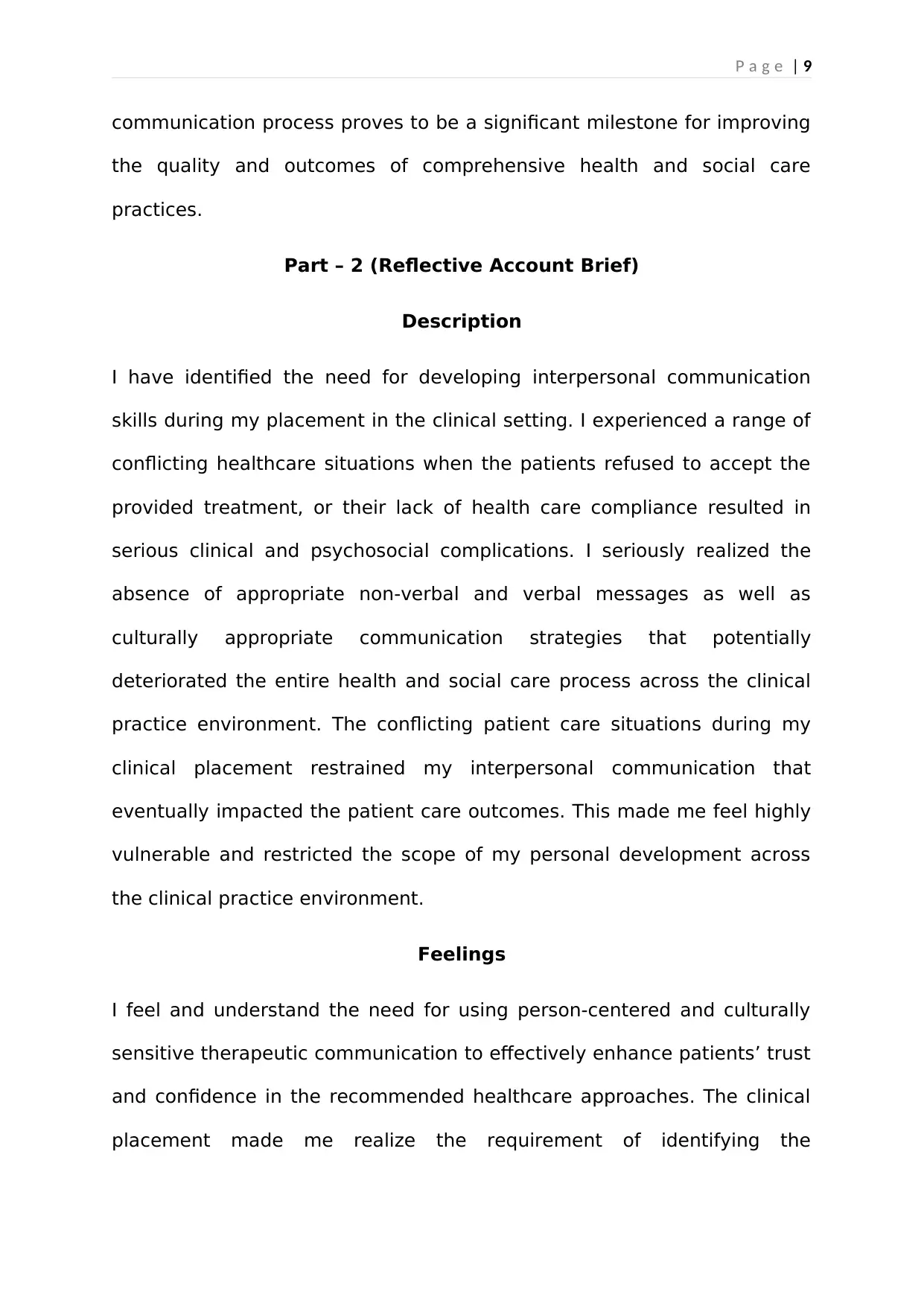
P a g e | 9
communication process proves to be a significant milestone for improving
the quality and outcomes of comprehensive health and social care
practices.
Part – 2 (Reflective Account Brief)
Description
I have identified the need for developing interpersonal communication
skills during my placement in the clinical setting. I experienced a range of
conflicting healthcare situations when the patients refused to accept the
provided treatment, or their lack of health care compliance resulted in
serious clinical and psychosocial complications. I seriously realized the
absence of appropriate non-verbal and verbal messages as well as
culturally appropriate communication strategies that potentially
deteriorated the entire health and social care process across the clinical
practice environment. The conflicting patient care situations during my
clinical placement restrained my interpersonal communication that
eventually impacted the patient care outcomes. This made me feel highly
vulnerable and restricted the scope of my personal development across
the clinical practice environment.
Feelings
I feel and understand the need for using person-centered and culturally
sensitive therapeutic communication to effectively enhance patients’ trust
and confidence in the recommended healthcare approaches. The clinical
placement made me realize the requirement of identifying the
communication process proves to be a significant milestone for improving
the quality and outcomes of comprehensive health and social care
practices.
Part – 2 (Reflective Account Brief)
Description
I have identified the need for developing interpersonal communication
skills during my placement in the clinical setting. I experienced a range of
conflicting healthcare situations when the patients refused to accept the
provided treatment, or their lack of health care compliance resulted in
serious clinical and psychosocial complications. I seriously realized the
absence of appropriate non-verbal and verbal messages as well as
culturally appropriate communication strategies that potentially
deteriorated the entire health and social care process across the clinical
practice environment. The conflicting patient care situations during my
clinical placement restrained my interpersonal communication that
eventually impacted the patient care outcomes. This made me feel highly
vulnerable and restricted the scope of my personal development across
the clinical practice environment.
Feelings
I feel and understand the need for using person-centered and culturally
sensitive therapeutic communication to effectively enhance patients’ trust
and confidence in the recommended healthcare approaches. The clinical
placement made me realize the requirement of identifying the
Paraphrase This Document
Need a fresh take? Get an instant paraphrase of this document with our AI Paraphraser
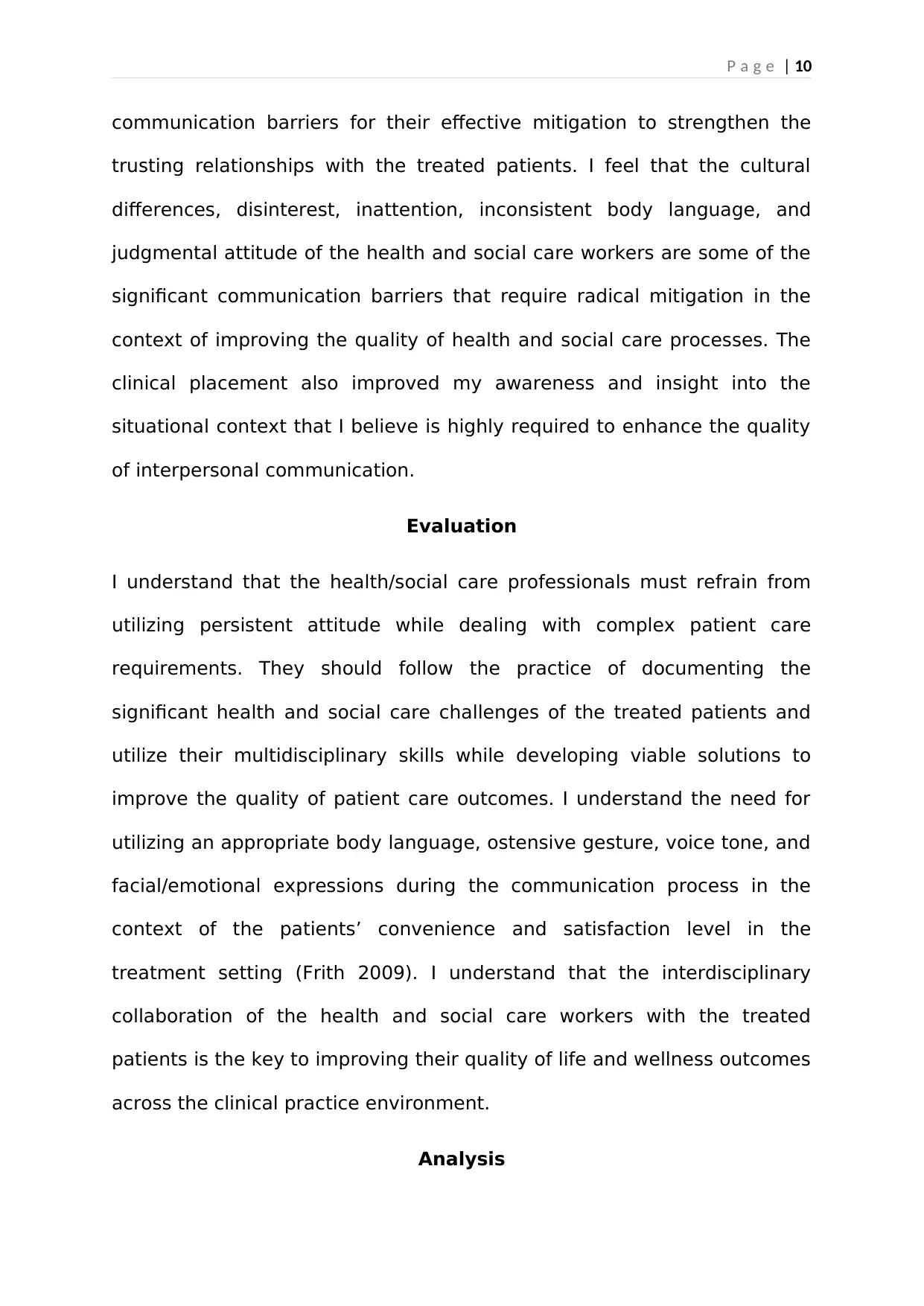
P a g e | 10
communication barriers for their effective mitigation to strengthen the
trusting relationships with the treated patients. I feel that the cultural
differences, disinterest, inattention, inconsistent body language, and
judgmental attitude of the health and social care workers are some of the
significant communication barriers that require radical mitigation in the
context of improving the quality of health and social care processes. The
clinical placement also improved my awareness and insight into the
situational context that I believe is highly required to enhance the quality
of interpersonal communication.
Evaluation
I understand that the health/social care professionals must refrain from
utilizing persistent attitude while dealing with complex patient care
requirements. They should follow the practice of documenting the
significant health and social care challenges of the treated patients and
utilize their multidisciplinary skills while developing viable solutions to
improve the quality of patient care outcomes. I understand the need for
utilizing an appropriate body language, ostensive gesture, voice tone, and
facial/emotional expressions during the communication process in the
context of the patients’ convenience and satisfaction level in the
treatment setting (Frith 2009). I understand that the interdisciplinary
collaboration of the health and social care workers with the treated
patients is the key to improving their quality of life and wellness outcomes
across the clinical practice environment.
Analysis
communication barriers for their effective mitigation to strengthen the
trusting relationships with the treated patients. I feel that the cultural
differences, disinterest, inattention, inconsistent body language, and
judgmental attitude of the health and social care workers are some of the
significant communication barriers that require radical mitigation in the
context of improving the quality of health and social care processes. The
clinical placement also improved my awareness and insight into the
situational context that I believe is highly required to enhance the quality
of interpersonal communication.
Evaluation
I understand that the health/social care professionals must refrain from
utilizing persistent attitude while dealing with complex patient care
requirements. They should follow the practice of documenting the
significant health and social care challenges of the treated patients and
utilize their multidisciplinary skills while developing viable solutions to
improve the quality of patient care outcomes. I understand the need for
utilizing an appropriate body language, ostensive gesture, voice tone, and
facial/emotional expressions during the communication process in the
context of the patients’ convenience and satisfaction level in the
treatment setting (Frith 2009). I understand that the interdisciplinary
collaboration of the health and social care workers with the treated
patients is the key to improving their quality of life and wellness outcomes
across the clinical practice environment.
Analysis
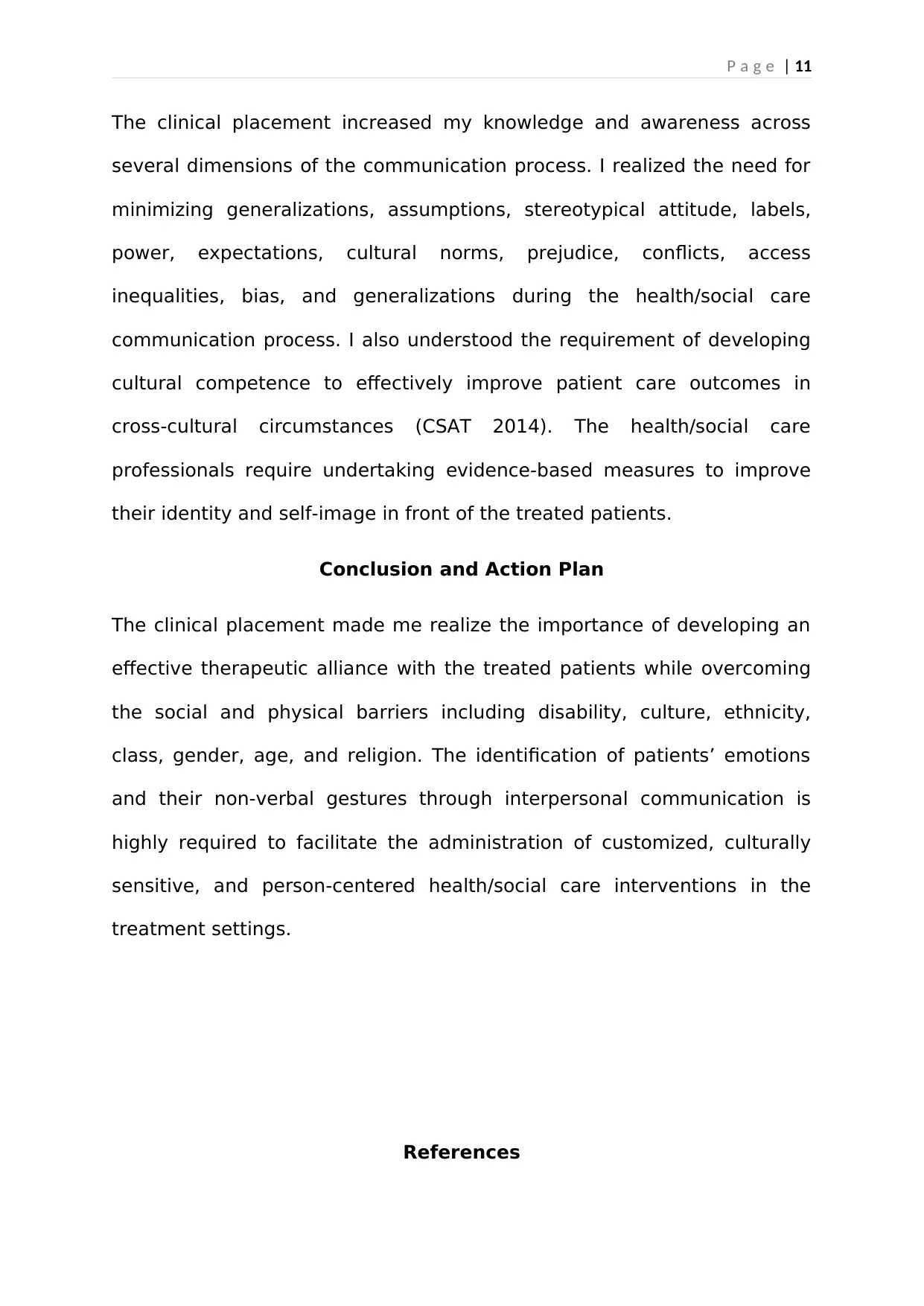
P a g e | 11
The clinical placement increased my knowledge and awareness across
several dimensions of the communication process. I realized the need for
minimizing generalizations, assumptions, stereotypical attitude, labels,
power, expectations, cultural norms, prejudice, conflicts, access
inequalities, bias, and generalizations during the health/social care
communication process. I also understood the requirement of developing
cultural competence to effectively improve patient care outcomes in
cross-cultural circumstances (CSAT 2014). The health/social care
professionals require undertaking evidence-based measures to improve
their identity and self-image in front of the treated patients.
Conclusion and Action Plan
The clinical placement made me realize the importance of developing an
effective therapeutic alliance with the treated patients while overcoming
the social and physical barriers including disability, culture, ethnicity,
class, gender, age, and religion. The identification of patients’ emotions
and their non-verbal gestures through interpersonal communication is
highly required to facilitate the administration of customized, culturally
sensitive, and person-centered health/social care interventions in the
treatment settings.
References
The clinical placement increased my knowledge and awareness across
several dimensions of the communication process. I realized the need for
minimizing generalizations, assumptions, stereotypical attitude, labels,
power, expectations, cultural norms, prejudice, conflicts, access
inequalities, bias, and generalizations during the health/social care
communication process. I also understood the requirement of developing
cultural competence to effectively improve patient care outcomes in
cross-cultural circumstances (CSAT 2014). The health/social care
professionals require undertaking evidence-based measures to improve
their identity and self-image in front of the treated patients.
Conclusion and Action Plan
The clinical placement made me realize the importance of developing an
effective therapeutic alliance with the treated patients while overcoming
the social and physical barriers including disability, culture, ethnicity,
class, gender, age, and religion. The identification of patients’ emotions
and their non-verbal gestures through interpersonal communication is
highly required to facilitate the administration of customized, culturally
sensitive, and person-centered health/social care interventions in the
treatment settings.
References
⊘ This is a preview!⊘
Do you want full access?
Subscribe today to unlock all pages.

Trusted by 1+ million students worldwide
1 out of 16
Related Documents
Your All-in-One AI-Powered Toolkit for Academic Success.
+13062052269
info@desklib.com
Available 24*7 on WhatsApp / Email
![[object Object]](/_next/static/media/star-bottom.7253800d.svg)
Unlock your academic potential
Copyright © 2020–2025 A2Z Services. All Rights Reserved. Developed and managed by ZUCOL.





